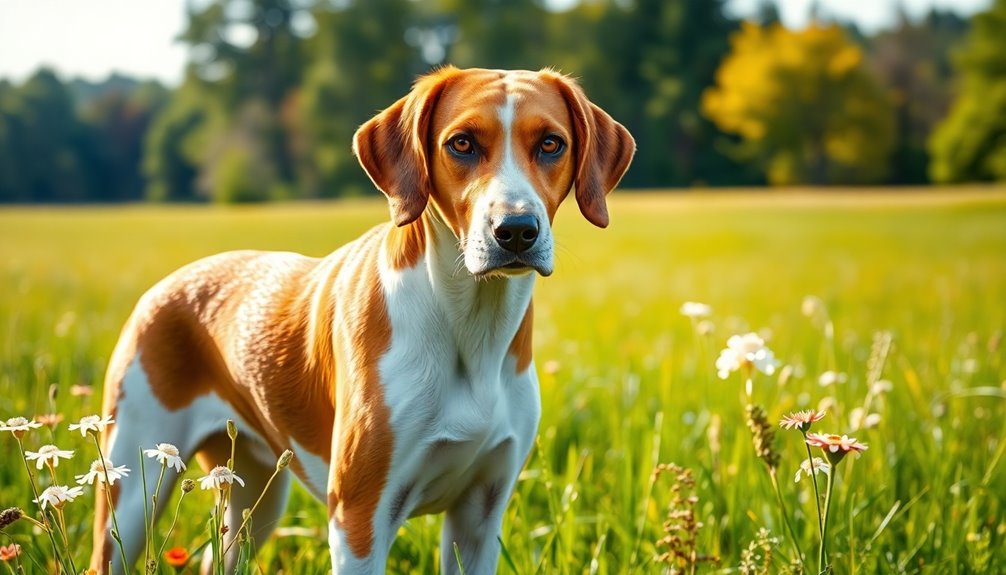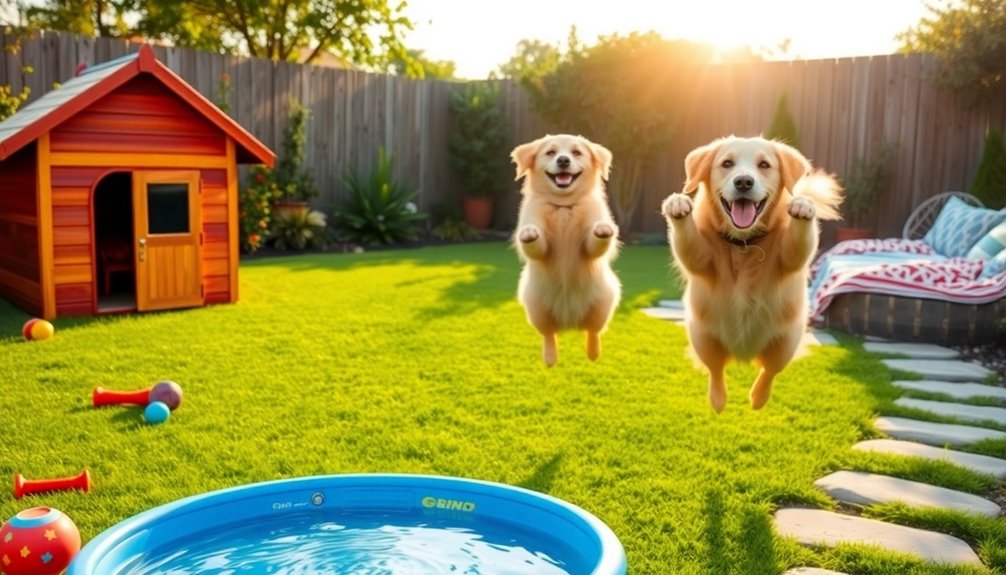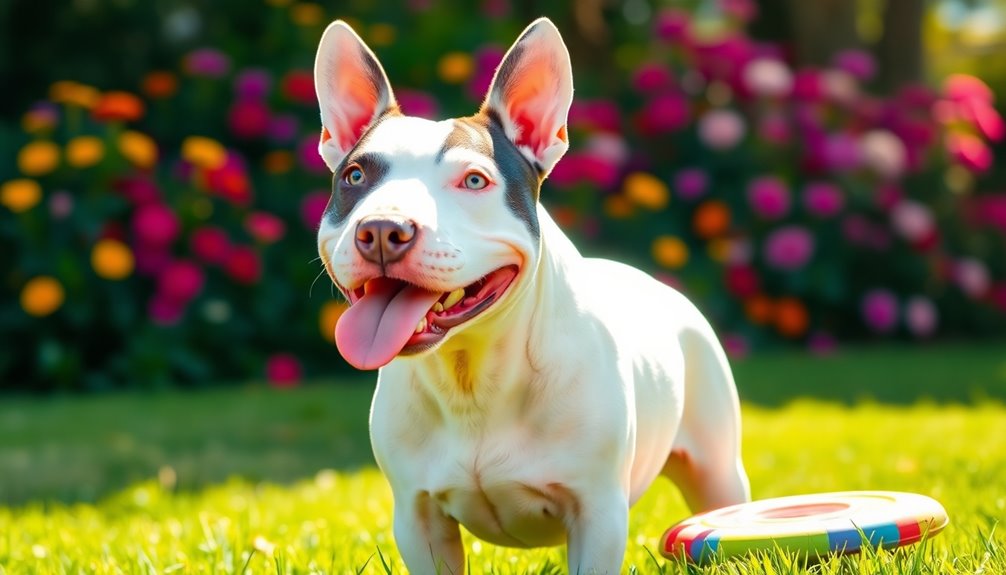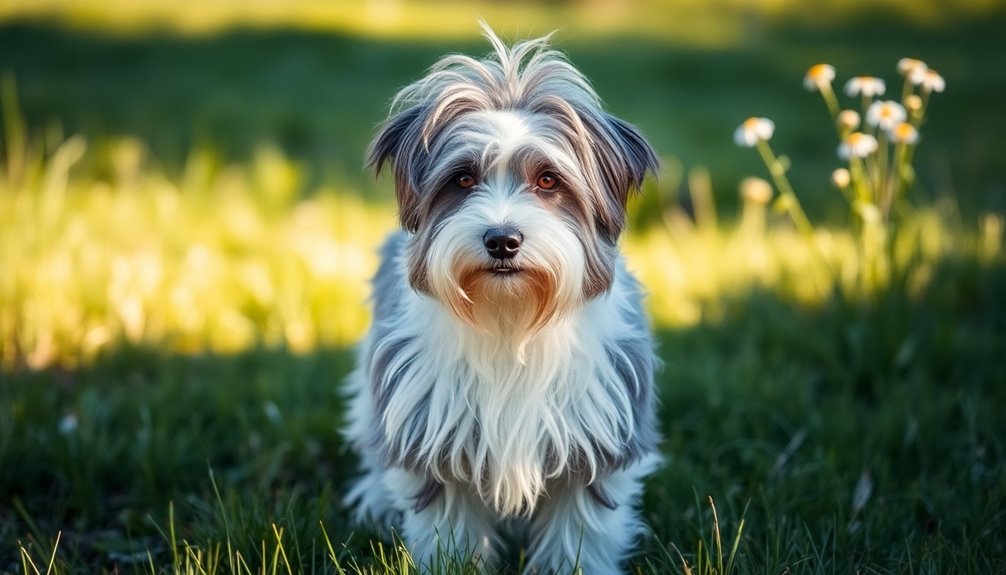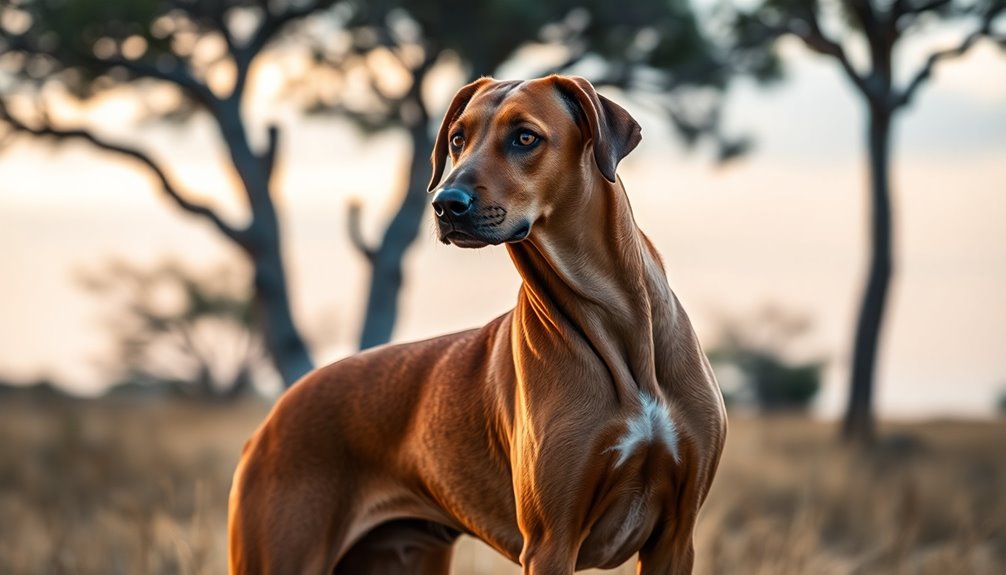The American Foxhound is a skilled hunter and a devoted companion, bringing a unique blend of energy and affection. With a height of 20 to 25 inches and a smooth coat in various colors, they're not just great for hunting but also thrive as family pets. These dogs are gentle yet spirited, making them excellent with children. They need plenty of exercise—about one to two hours daily—to keep them happy and healthy. Their independent nature requires early training and socialization to ensure good behavior. Stick around to discover more about this charming and active breed!
Key Takeaways
- The American Foxhound combines agility and a strong prey drive, making it an exceptional hunter in the field.
- With a gentle and affectionate temperament, it is well-suited for families and companionship.
- Historically bred by George Washington for adaptability, it plays a significant role in American hunting traditions.
- Regular exercise and socialization enhance its hunting instincts while ensuring it remains a well-rounded pet.
- Health-conscious care and preventive measures are essential for maintaining the breed's robust health and longevity.
Introduction
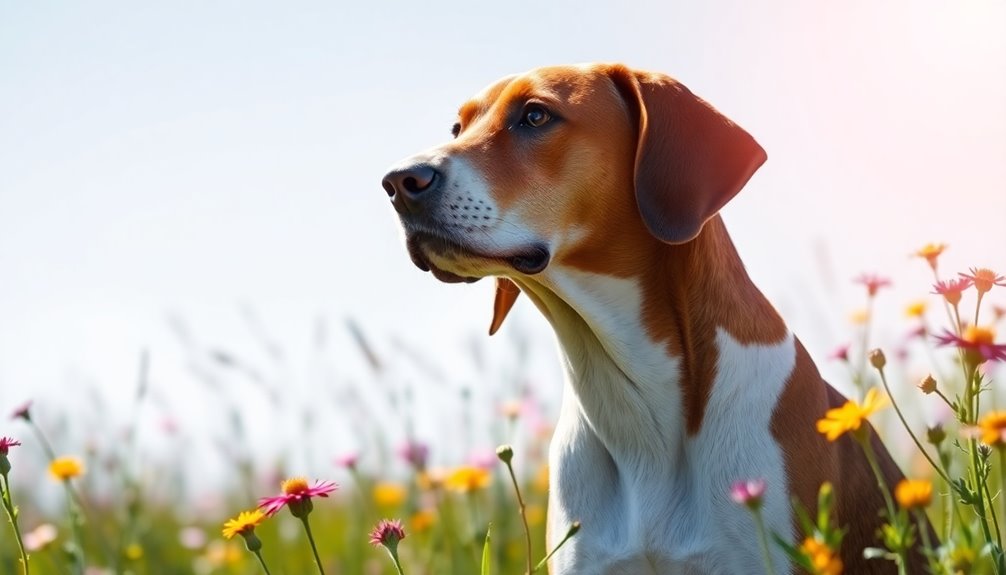
The American Foxhound is a remarkable breed known for its athleticism and friendly nature. Standing 21 to 25 inches tall for males and 20 to 24 inches for females, this breed boasts a sturdy build, weighing between 50 and 71 pounds. With a short, smooth coat that can come in various colors like white, black, tan, or tricolor, they're not just beautiful; they're also built for performance.
These dogs are incredibly affectionate and friendly, making them great companions. However, they're also independent and can be stubborn, especially around strangers. You'll find they thrive in homes where they've company, whether from people or other dogs. It's important to note that American foxhounds are vocal by nature, which can be disruptive in urban settings.
Their strong prey drive means they'll need early and consistent training to harness their instincts effectively. American Foxhounds require a significant amount of daily exercise due to their high energy levels, making them ideal partners for hiking or running.
Their loyal and alert nature makes them excellent guardians, but don't forget that they can easily get bored without enough stimulation. With the right environment, you'll discover a loving and devoted friend in the American Foxhound.
History and Origin
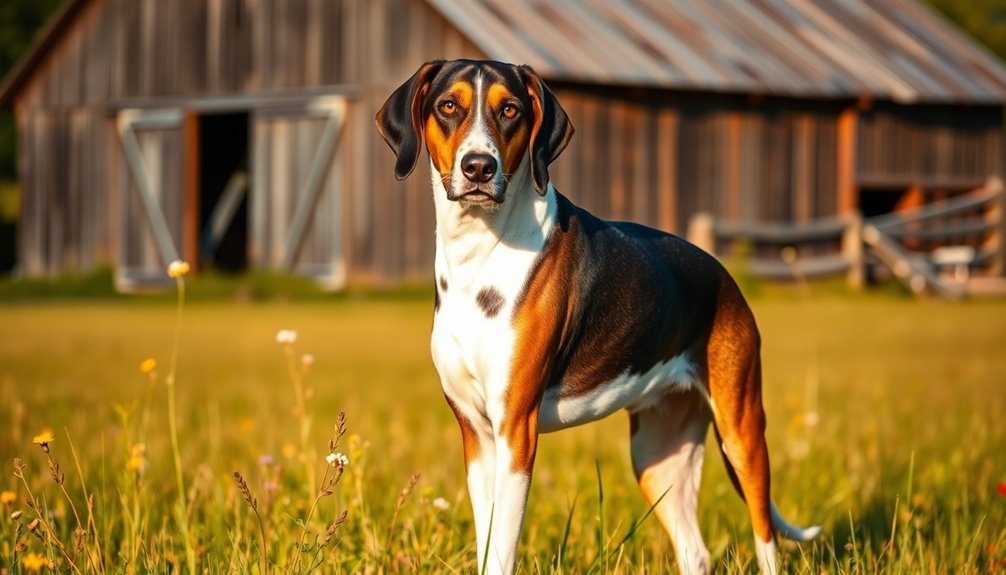
The American Foxhound traces its roots back to the 17th century when English Foxhounds were brought to colonial America. As a versatile hunting companion, these dogs were bred to adapt to the American landscape, enhancing their skills for tracking and speed. Over time, various hound breeds contributed to their development, solidifying their place in American hunting culture. Their average lifespan ranges from 11 to 13 years, reflecting their robust health and endurance as hunting dogs.
Where and when the breed originated
In the mid-17th century, English foxhounds made their way to colonial America, thanks to Robert Brooke, who brought them over in 1650.
These hounds became part of the Brooke family for nearly three centuries, laying roots in the Crown Colony of North America. Early breeding involved hounds from both France and England, creating a foundation for what would evolve into the American Foxhound.
As the breed developed, it drew heavily from various European hounds. Notably, George Washington played a crucial role in refining the breed, receiving French foxhounds from Marquis de Lafayette in 1785. He crossbred these with the English foxhounds, incorporating Irish hounds into his breeding program. Washington meticulously documented his breeding efforts, which helped solidify the American Foxhound as a distinct breed. This breed is renowned for its adaptability and endurance, making it suitable for a variety of hunting terrains.
Fox Hunting Companion Breed
Many people may not realize that the American Foxhound was specifically bred to be an exceptional companion in fox hunting. Originating from European hounds brought to America in the 1600s and 1700s, these dogs were developed for their remarkable tracking abilities. With a keen sense of smell, they excel at chasing wild quarry, allowing hunters on horseback to follow their lead.
Typically hunting in packs of 15 to 20, these hounds communicate effectively with their strong voices, guiding hunters during the chase. Their ability to be an exceptional scent hound allows them to track prey with remarkable precision, making them invaluable during hunts.
George Washington played a significant role in the breed's development, breeding and owning Foxhounds that contributed to their refinement. Historically, these dogs have served multiple roles, from field trial hounds to pack hounds for hunting clubs. Although modern practices emphasize the thrill of the chase rather than the kill, the American Foxhound remains a vital companion in the hunt.
With their athletic build, high energy levels, and need for daily exercise, these dogs thrive in country living, where they can run and play. Their companionship during the hunt is invaluable, reinforcing the bond between hound and hunter.
Physical Characteristics

When you look at an American Foxhound, you'll notice its impressive size, with males standing between 22 to 25 inches tall and weighing up to 75 pounds.
Their short, hard coat comes in a variety of colors, including the classic black, white, and tan.
One prominent feature that catches your eye is their long, droopy ears, which add to their distinctive appearance. Additionally, they are known for their musical bark, which is a characteristic trait of the breed.
Size, weight, and coat details
The American Foxhound typically stands between 21 to 25 inches tall at the withers, with males generally being larger than females. Males usually weigh between 45 to 65 pounds, while females range from 40 to 60 pounds. Some males can reach heights of 26 to 29 inches and weigh up to 70 pounds, depending on their breeding.
Ideally, males should be no shorter than 22 inches and no taller than 25 inches, while females shouldn't be under 21 inches or over 24 inches.
The coat of the American Foxhound is short to medium in length, smooth, hard, and close to the body. You'll often see a mix of white, black, and tan colors. They tend to shed quite a bit, but regular weekly brushing keeps the shedding manageable. Grooming is low maintenance, making them a practical choice for busy owners. Their population is maintained through breeding programs, ensuring that this breed remains stable and widely available.
Their long, straight-boned legs contribute to their agility, while the narrow chest distinguishes them from the English Foxhound. With a straight, square-cut muzzle and large, domed skull, they possess large brown or hazel eyes that are set widely apart, adding to their expressive appearance.
Long, Droopy Ears
American Foxhounds have uniquely long, droopy ears that significantly contribute to their distinctive appearance. These ears hang down, resting gently on the top of their heads, and are set moderately low, aligning with the outer corners of their eyes. When drawn out, their ears can nearly reach the tip of their noses. This broad, fine-textured ear structure has minimal erectile power, making them somewhat floppy without pointing back up.
However, this adorable feature comes with responsibilities. The long, floppy ears can trap moisture, making American Foxhounds particularly prone to ear infections. You should be vigilant, as infections can lead to serious issues like permanent hearing damage or even facial paralysis. The need for proper ear care is essential due to their unique ear structure.
Regular cleaning is crucial to prevent these infections. Check their ears weekly for debris and clean them monthly to maintain ear health.
Watch for signs of ear problems like redness, swelling, or dark discharge. If you notice your Foxhound frequently scratching at their ears or shaking their head, it's time to consult a veterinarian.
Keeping your dog's ears clean and healthy ensures they can hear your commands and enjoy their time with you.
Temperament and Personality
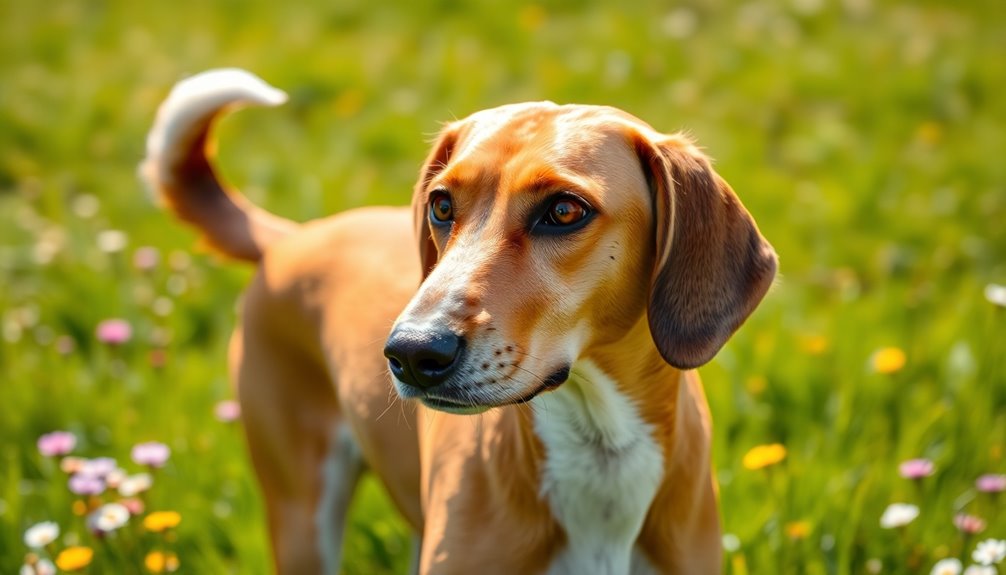
The American Foxhound has a gentle yet spirited demeanor that makes them a joy to have around. They're well-suited for families, individuals, or even homes with other pets, thriving on companionship and interaction. While they can be independent and a bit stubborn, their loving nature shines through, especially with proper socialization. Their companionable nature ensures they form strong bonds with family members, making them a beloved addition to any household.
Gentle yet Spirited Demeanor
With a gentle nature and a spirited personality, American Foxhounds make delightful companions for families and individuals alike. Their docile and sweet demeanor makes them easygoing pets that rarely show aggression.
While they're friendly and sociable, you might notice that they can be a bit shy or reserved around new people. However, well-socialized Foxhounds adapt easily, forming bonds with other pets and humans. These dogs thrive on interaction and enjoy the company of everyone, from children to other animals. Their high energy levels mean they're always ready for playtime, making them excellent companions for active households. They love running and exploring, so be prepared for plenty of outdoor activities! Additionally, their high energy levels necessitate daily physical activity to keep them healthy and happy. Engaging in play with educational and skill-building toys can also help channel their energy positively.
While they possess an independent streak and may appear aloof at times, American Foxhounds are intelligent and capable of learning commands quickly. Their strong instincts can sometimes override training, so consistent and positive reinforcement is key to helping them manage their independence.
With their loving and affectionate disposition, American Foxhounds truly embody the spirit of companionship, ensuring they bring joy to your life.
Suitability for families, individuals, or other pets
For families seeking a gentle and playful companion, American Foxhounds are an ideal choice. They're friendly and gentle with children, receiving a top rating of 5 out of 5 from the American Kennel Club for their compatibility with young ones.
Their high energy levels make them perfect for active families who love outdoor activities and playtime. They thrive in homes with large yards where they can run and explore. Additionally, they are known for their high-energy nature, which means they will always be ready for a game of fetch or a long hike. Regular outings for socialization are beneficial to their development and help ensure they are well-adjusted.
When it comes to other dogs, American Foxhounds generally get along well, especially with those that share their energy levels. They enjoy being part of a pack and can form strong bonds with their canine companions. However, socialization is essential for ensuring harmony.
As for other pets, while many American Foxhounds can coexist peacefully with cats and small animals, it's crucial to monitor interactions closely. Some may retain a predatory drive, so patience and proper introductions are key.
Training them requires consistency due to their independent nature. With the right approach, you'll find that their sociable and friendly temperament makes them a wonderful addition to any home.
Just remember, they need regular exercise and mental stimulation to keep boredom at bay!
Health and Lifespan
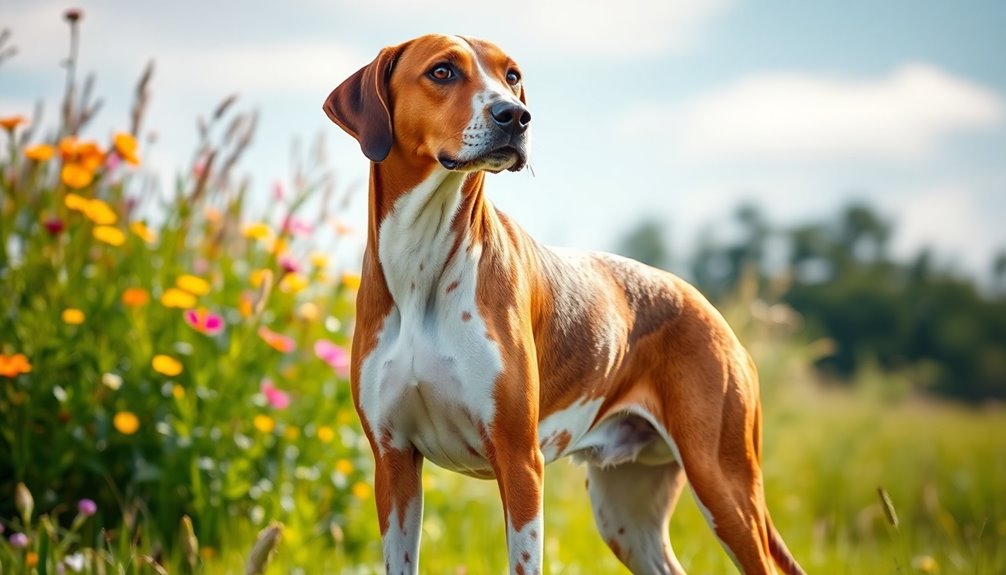
When it comes to your American Foxhound's health and lifespan, you can expect them to live between 10 to 13 years on average. While they're generally a healthy breed, they can be prone to specific health issues like hip dysplasia and dental diseases. To keep your hound in top shape, regular exercise and preventive care are essential. Additionally, they are predisposed to hip dysplasia, which makes it crucial to monitor their activity levels and seek veterinary advice if you notice any signs of limping or hip pain. Regular grooming can also help control pet hair that may contribute to skin irritations.
Typical lifespan of the breed
The typical lifespan of an American Foxhound ranges from 10 to 13 years, reflecting a general trait of the breed. As a medium-sized hound, this dog usually weighs between 60 to 70 pounds for males and 60 to 65 pounds for females. Standing 21 to 25 inches tall, their lean and athletic build contributes to their overall health and longevity.
While individual dogs may vary, the American Foxhound is generally considered a hardy breed. Regular veterinary check-ups play a crucial role in ensuring your dog remains in good health throughout its life. Moreover, maintaining a healthy weight is essential, as obesity can lead to various health issues. Feeding your dog a species-appropriate diet can further enhance their overall health and longevity.
These dogs thrive in different living conditions, whether in rural or urban settings, but they require considerable daily exercise to stay fit and happy. Without enough physical activity, they might suffer from depression, impacting their quality of life.
Their low-maintenance coat also helps keep grooming simple, allowing you to focus on enjoying your time together. By providing proper care, you can help your American Foxhound live a long and healthy life, maximizing those valuable years you share.
Common health concerns or genetic predispositions
Many American Foxhounds encounter specific health concerns and genetic predispositions that potential owners should be aware of. Hip and elbow dysplasia are common issues where the joints develop improperly, leading to arthritis and lameness. Thyroid problems like hypothyroidism can cause dry skin, hair loss, and weight gain. You should also watch for degenerative myelopathy, a progressive spinal cord disease that may result in paralysis.
Infections and parasites can also affect your Foxhound. They're vulnerable to viral and bacterial infections like parvo and distemper, which are preventable through vaccinations. Year-round protection against fleas, ticks, and heartworms is essential to avoid health complications. Additionally, be mindful of ear infections, which can arise from allergies or swimming. Regular veterinary check-ups can help detect and treat parasite infestations early.
Blood disorders like thrombocytopenia and von Willebrand's disease are common in the breed, requiring diagnostic testing. Other concerns include arthritis, dental diseases, and kidney problems.
As your Foxhound ages, cancer becomes a leading cause of death, making early detection crucial. Lastly, be aware of cryptorchidism, where undescended testicles can elevate cancer risk. Keeping an eye on these issues can help ensure a long, healthy life for your beloved companion.
Tips for maintaining health and wellness
To ensure your American Foxhound stays healthy and lives a long life, focus on a balanced approach that includes proper diet, regular exercise, grooming, and routine veterinary care.
Start with a nutrient-rich diet, emphasizing high-quality protein sources for muscle development. Incorporate whole grains, fruits, and vegetables for essential carbohydrates and vitamins. Aim for low-fat dog food to prevent weight gain, adjusting daily intake based on your dog's activity level, age, and metabolism—typically 2-3 cups.
Next, provide plenty of physical stimulation. Engage in activities like running, dog sports, and field trials to keep your Foxhound fit and prevent behavior problems. Ensure they've a safe, fenced-in area for exploration and play. This breed's excellent hunting and chasing abilities make them eager participants in outdoor activities.
Grooming is also vital. Brush your dog's medium-length coat weekly with a firm bristle brush to remove dirt and distribute natural oils. Bathe them as needed, clean their ears regularly, and trim nails if they don't wear down naturally.
Lastly, don't forget routine vet check-ups and socialization. Your Foxhound thrives on companionship, so provide mental stimulation through games to keep them happy and healthy.
Care Requirements
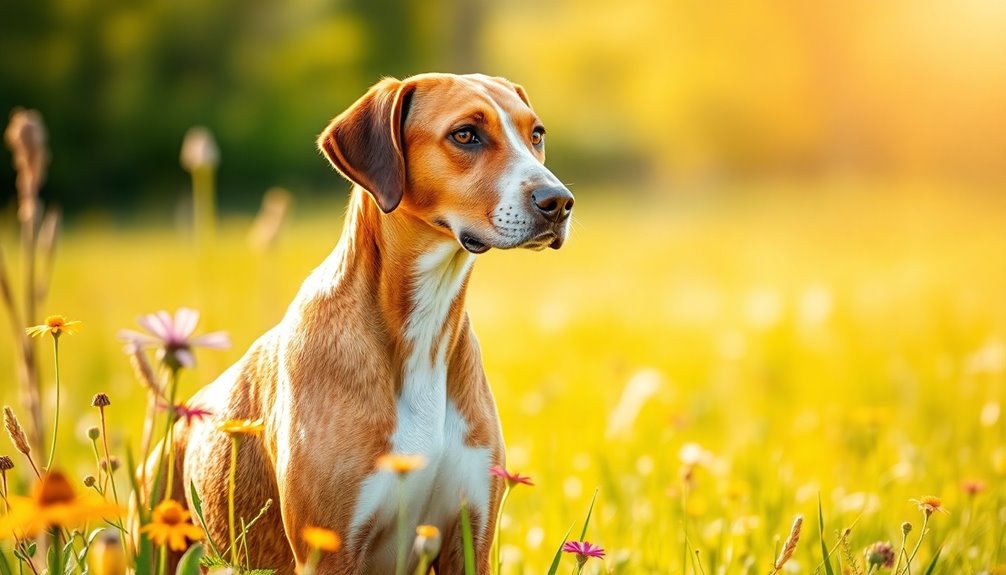
Caring for your American Foxhound involves meeting its exercise needs, maintaining a healthy diet, and managing grooming requirements. You'll find that they shed minimally and have an easy-to-care-for coat, but they still need regular brushing and occasional baths. Additionally, it's important to ensure they receive at least one hour of daily exercise to keep them physically and mentally stimulated.
Minimal Shedding, Easy Grooming
The American Foxhound's grooming needs are minimal, making it an appealing choice for those who prefer low-maintenance pets. You'll only need to brush your Foxhound about once a week to keep its short, smooth coat looking great. Regular brushing not only helps reduce shedding but also prevents any potential matting or tangling, which is uncommon for this breed. A bristle brush or grooming mitt works well for effective grooming, while soft brushes or hound gloves can also do the trick. Maintaining a consistent grooming schedule is important to prevent matted fur.
Bathing your Foxhound isn't usually necessary unless they get extremely dirty. When you do bathe them, use warm water and a comfortable temperature to keep them relaxed. Make sure to apply shampoo thoroughly and rinse well to avoid any soap residue. Luckily, you won't need conditioner for their coat, as it's easy to maintain. Just remember to avoid frequent baths to prevent dry, itchy skin.
After outdoor activities, always check for ticks or scrapes, and trim excess hair from their paw pads.
Regular dental care, including brushing their teeth and professional cleanings, is also essential for their overall well-being.
Exercise requirements and energy levels
American Foxhounds thrive on activity, requiring 1 to 2 hours of exercise daily to keep their high energy levels in check. Activities like walking, jogging, or playtime in a safe, fenced area are essential for their happiness and health. If you don't meet their exercise needs, you'll likely see restlessness and destructive behaviors emerge.
To keep them engaged, vary your routes during walks or jogs. Running short distances is beneficial, but it doesn't have to be a sprint. Canine sports like tracking games, obedience rallies, and agility tests can also provide excellent physical and mental stimulation. Incorporating games like fetch in a secure area is a great way to keep them active.
Mental stimulation is just as crucial. Consider puzzle toys or training sessions to challenge their minds. Early socialization and strong leadership help channel their hunting instincts effectively. Additionally, their alertness as determined scent trackers makes them especially responsive to engaging activities.
Lastly, ensure you have ample space for them to roam and explore safely, avoiding open areas without supervision due to their strong prey drive. By meeting their exercise and mental stimulation needs, you'll prevent boredom and ensure a well-balanced, happy Foxhound.
Feeding tips and diet recommendations
To keep your American Foxhound healthy and energetic, focus on providing a balanced diet rich in high-quality protein sources. Include animal-based proteins like beef, chicken, turkey, lamb, duck, eggs, and fish. Protein is essential for muscle development and supports your dog's active lifestyle. Additionally, since American Foxhounds are known for their energetic nature, their diet should provide the necessary nutrients to fuel their active lifestyle.
Don't forget about offal; it acts as a natural multivitamin, delivering crucial macronutrients and micronutrients. Your dog's diet should be tailored to their life stage and energy needs. Incorporate essential fatty acids and omegas for optimal health, while small amounts of carbohydrates from vegetables, herbs, and berries can be beneficial.
Avoid high-starch foods like rice and legumes. Feed your American Foxhound 2-4 cups of food daily, split into two meals. Adjust portions based on their size, age, weight, and health to prevent obesity. A visible rib cage is normal, so monitor their weight closely.
Hydration is key, as a dog's body is about 70% water. Consider a raw diet with high moisture content and FEDIAF-approved pre-prepared raw dog food for balanced nutrition. Ground and recreational bones can also support digestion and bone health.
Training and Socialization
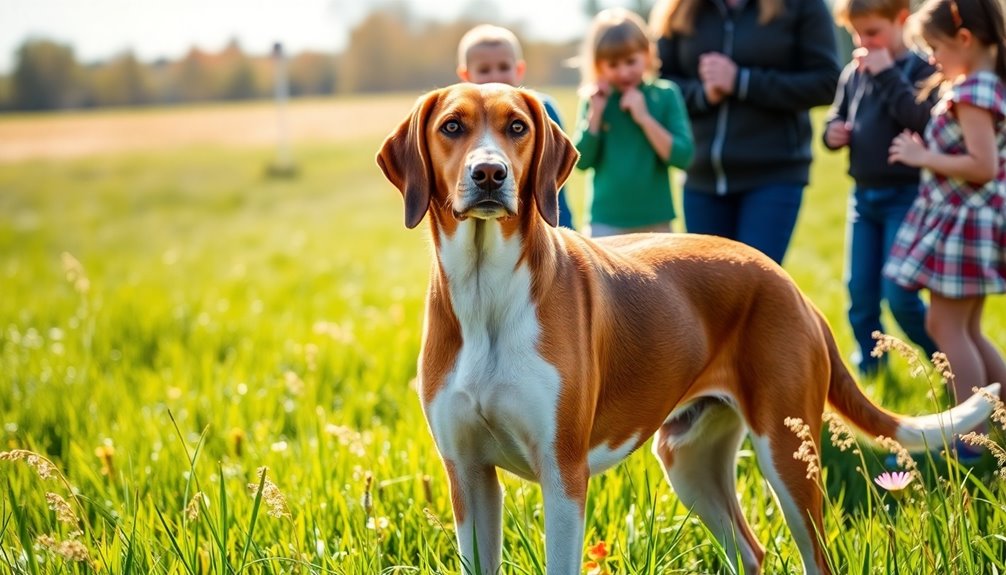
When training your American Foxhound, it's important to embrace their moderately independent nature. Introduce them to diverse environments to help curb any leash pulling tendencies and enhance their adaptability. Engaging in daily exercise routines will also provide them with the physical outlet they need to stay focused during training sessions.
Moderately Independent Training Style
For effective training of the American Foxhound, it's crucial to consider their moderately independent nature.
Begin in a quiet, distraction-free area to help your dog focus. Choose a consistent training location that minimizes visual and auditory stimulation, avoiding high foot traffic or noise. This designated space reinforces routine and helps your Foxhound concentrate.
Utilize positive reinforcement techniques, like treats, praise, and playtime, to reward good behavior. Ensure your rewards are immediate and consistent, making training sessions enjoyable. Avoid punishment or negative methods, as they can lead to fear and resistance. The American Foxhound's friendly demeanor makes them eager to please, which can be leveraged during training. Incorporating high-quality protein sources into their diet can also help improve their overall focus and energy during training sessions.
Start training early, ideally around eight weeks old, and keep sessions short and frequent to maintain interest. Be patient, as their independent streak may require extra time to grasp commands. Consistency is key—establish clear expectations and stick to them.
Finally, while your American Foxhound is generally good with children and other pets, remember to supervise interactions. Teaching children how to engage with dogs properly will ensure positive experiences for everyone involved.
With the right approach, your Foxhound can thrive in training and become a well-mannered family companion.
Introduce to Diverse Environments
Expanding your American Foxhound's training to include diverse environments is key to developing a well-adjusted adult dog. Start during the critical period of 8-12 weeks by introducing your puppy to various household settings, sounds, and gentle handling.
Ensure these experiences are positive to avoid overwhelming your pup. Use this time to teach basic commands like 'sit' and 'stay' while also focusing on proper housebreaking.
As your puppy grows, from 12-16 weeks, expand social interactions with new people and well-behaved pets. During this time, the breed's exceptional scenting ability can be harnessed for engaging activities like tracking games.
Begin leash training to help your Foxhound get comfortable walking on a leash and continue reinforcing obedience commands. Introduce your puppy to new environments such as friends' houses and dog parks, supervising interactions to create safe experiences.
At 4-6 months, take your pup to dog parks and training classes.
Gradually introduce busier surroundings to build confidence. By 6-12 months, maintain a predictable routine and keep exposing your Foxhound to various environments and people.
Use positive reinforcement techniques like treats and praise to reinforce good behavior, ensuring your dog grows into a well-behaved, adaptable companion.
Leash Pulling Tendencies
Leash pulling can be a frustrating challenge for American Foxhound owners, but understanding the root of this behavior makes training more effective. Derived from their wolf ancestors, Foxhounds often feel compelled to take charge during walks, leading to that instinctual pulling. Their strong prey drive amplifies this, as they think they need to make crucial decisions throughout the outing. Research indicates that early training and socialization can significantly improve a dog's behavior, fostering critical thinking skills as they learn to respond to commands.
To tackle this behavior, you can implement several effective training techniques. First, stop walking immediately when your dog pulls, waiting for the leash to slacken before you proceed. The "change direction" technique—turning 180 degrees and walking the other way—can also be highly effective. This method encourages a more relaxed environment, promoting loose leash walking that benefits both you and your dog.
Avoid jerking the leash, as this can harm your dog and won't solve the issue. Instead, focus on loose leash training, rewarding your Foxhound when they walk beside you.
Using a sturdy, non-retractable leash between 4 to 5 feet long offers better control. Train in a quiet area to limit distractions, and be patient; consistency is key. Studies show that engaging dogs in interactive training sessions enhances their learning experience, making them more receptive to commands.
Establish boundaries, show calm assertiveness, and mix up your walking routine to keep your dog engaged. With time, your Foxhound will learn to walk nicely on a leash.
Ideal Living Environment
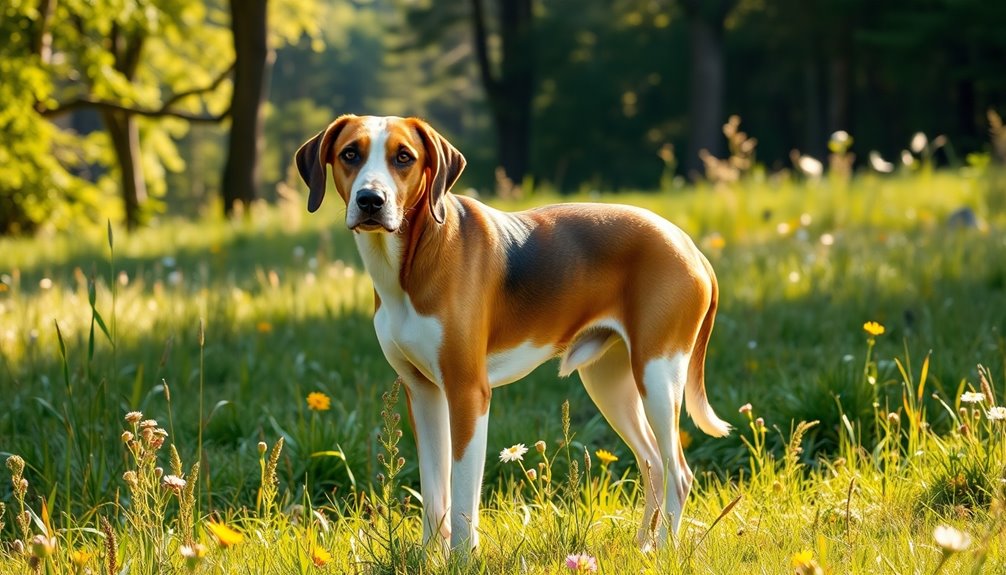
To keep your American Foxhound happy and healthy, you'll need a spacious backyard for plenty of exercise. This breed thrives in environments where they can run and play, so a secure area is essential. Additionally, they handle heat better than cold, so be prepared to provide shade and water during warm days. Their loyal and fun-loving nature makes them great companions for active families who can keep up with their energetic needs.
Spacious Backyard for Exercise
How can you provide the ideal environment for an American Foxhound? A spacious, secure backyard is essential for their exercise needs. These dogs require at least an hour of vigorous physical activity daily, so having a fenced-in area allows them to run and play safely. A large yard gives them the freedom to engage in activities like fetch, tug of war, or agility training without the risk of wandering off.
To keep your Foxhound engaged, mix up their exercise routine. Explore different walking routes or visit various parks to stimulate their senses. Incorporating dog sports like Fast CAT not only activates their prey drive but also provides valuable mental stimulation. You can even create agility courses using household items for a fun, budget-friendly option. Additionally, their strong prey drive may lead them to chase after small animals, so supervision during outdoor play is important.
Additionally, ensure the backyard is free from hazards and distractions. Regular training sessions and socialization are crucial for managing their strong prey drive, so include various people, environments, and animals in their experiences.
Moderate Tolerance for Heat
While American Foxhounds can handle warm weather, it's essential to create an ideal living environment that supports their moderate heat tolerance. Their short, dense coat helps dissipate heat, but they still need protection from extreme temperatures. Ensure your Foxhound has access to plenty of shade and fresh water, especially during sweltering days. With their medium to large size, standing 21-25 inches tall and weighing 65-75 pounds, their athletic build aids in heat regulation, making them relatively adaptable. However, even with their natural adaptations, they can suffer from overheating if left in direct sunlight for too long. Heat-sensitive breeds like American Foxhounds benefit from regular breaks in cooler areas during outdoor play. Encourage your Foxhound to enjoy outdoor activities, but monitor their panting and behavior closely. They thrive in the sun but need breaks to cool down. Regular weekly brushing will keep their coat healthy and free of debris, which can also help with heat regulation.
Vocal Hunters With Distinctive Barks

When you're out in the field with an American Foxhound, you'll quickly notice their impressive vocalizations. These dogs, known for their strong scent-tracking abilities, communicate with distinctive barks that can be heard for miles. Their hunting and tracking abilities are further enhanced by their ability to work well in packs, making them effective at locating and pursuing game. It's no wonder George Washington favored them as his hunting companions; their vocal prowess is as essential to their hunting skills as their keen sense of smell.
Strong Scent-Tracking Abilities
What makes the American Foxhound stand out among hunting breeds is its remarkable scent-tracking abilities. With an exceptional sense of smell, these dogs possess a staggering number of scent receptors, allowing them to track scents over long distances and challenging terrains.
In fact, their sense of smell is 10,000 to 100,000 times more acute than yours! They dedicate 40 times more brain space to analyzing odors than humans do, a trait honed through generations of breeding for fox hunting.
When they catch a scent, you'll notice their determination; they often ignore commands, making recall a challenge. Their vocalizations, known as "brays," are distinctive and musical, alerting you to their progress on the trail while also communicating with other hounds.
These sounds can travel for miles, showcasing their vocal prowess. Primarily used for fox hunting, American Foxhounds excel in various roles, from search and rescue to law enforcement, due to their extraordinary scenting skills. They can detect both hot and cold scents, proving versatile beyond just hunting.
Their strong scent-tracking abilities truly make them invaluable companions in any tracking or hunting endeavor.
George Washington's Favorite Hunting Dog
Have you ever wondered which breed captured George Washington's heart during his hunting adventures? The American Foxhound was his favorite, a breed he helped shape through meticulous breeding.
In 1785, Washington received French hounds from Marquis de Lafayette, which he crossed with English and Irish hounds to create a faster, more agile dog perfect for American foxhunting.
Washington was a passionate foxhunter, inviting neighbors to join him on thrilling hunts for over three decades. He kept detailed journals documenting each chase, often noting the hounds' performance and even the fox's escape when he chose not to kill. This dedication highlights his love for both the hunt and the animals involved, as evidenced by his detailed records of hound activities and hunts.
The American Foxhound is medium-sized with a lean, athletic build and a short coat, often tri-colored. Their distinctive melodious bay, a unique bark that resembles a howl, makes them highly vocal, especially during hunts.
While they require plenty of exercise, their friendly nature makes them beloved family pets. However, their loud barks and strong prey drive mean they're best suited for rural living.
Washington's legacy lives on in these remarkable dogs, embodying the spirit of adventure and companionship he cherished.
Active Lifestyle Compatibility?

If you lead an active lifestyle, an American Foxhound could be the perfect companion for you. These energetic dogs need at least 1-2 hours of exercise daily and thrive in environments where they can run and play. You'll want to ensure you have a large, securely fenced yard to keep them happy and healthy. Their excellent hunting abilities, particularly in tracking foxes, make them not only playful companions but also skilled partners in outdoor activities.
Energetic Companions for Active Owners
Embracing an active lifestyle, you'll find that American Foxhounds make exceptional companions for outdoor adventures. Their friendly and social nature means they thrive in family environments, enjoying activities like hiking, jogging, or bike rides alongside you.
These dogs are loyal and protective, always eager to be by your side, making them perfect partners for active families. Their exceptional hunting skills make them particularly suited for outdoor activities that engage both their minds and bodies.
Their intelligence combined with a hint of stubbornness means they need engaging activities to stay happy. They excel in canine sports, tracking games, and interactive play, so incorporating mental challenges like fetch or scent work can keep them entertained. Additionally, providing them with mental stimulation through activities like puzzle toys can enhance their cognitive abilities and prevent boredom.
This variety not only satisfies their natural instincts but also strengthens your bond.
American Foxhounds are adaptable and can coexist well with other pets, provided they're socialized early. They're especially great with older children, thanks to their gentle and affectionate demeanor.
Just remember, they don't like being left alone for too long, as they prefer companionship. By including them in your adventures and giving them the mental stimulation they crave, you'll create a fulfilling life together, ensuring they remain the energetic and loving companions you need.
Exercise Needs and Space Requirements
For American Foxhounds, meeting their exercise needs is crucial to their well-being and happiness. These dogs require a minimum of 1-2 hours of exercise each day, which can include long walks, jogging, and engaging play sessions. They thrive on vigorous activities, so consider running or playing with another dog to help them release energy. Regular exercise promotes mental stimulation and reduces behavioral issues, making it essential for their overall health.
Mental stimulation is equally important, so incorporate puzzle toys and training sessions into their routine.
When it comes to exercise types, walking and jogging in secure, fenced areas are ideal. Games like fetch and tug-of-war are great for bonding and energy release. You might also explore agility training or canine sports like tracking and coursing to keep your Foxhound engaged.
Space is a key consideration. A large, securely fenced yard is perfect for them to run and explore safely. Due to their strong scenting instinct, supervised outdoor time is essential to prevent them from wandering off.
Apartment living may not suit this breed well, especially if you can't provide enough space and regular activity. If you're an active owner or family, a Foxhound can be a perfect companion for your outdoor adventures.
Frequently Asked Questions
Are American Foxhounds Good With Children and Other Pets?
Yes, American Foxhounds are generally great with children and other pets.
They're friendly, loyal, and energetic, making them ideal companions for active families. With proper training and socialization, they can adapt well to various environments.
Just ensure you supervise their interactions with young kids and small animals to avoid any issues.
Regular exercise and mental stimulation are essential to keep them calm and well-behaved, benefiting both your children and pets.
How Much Exercise Do American Foxhounds Need Daily?
American Foxhounds need at least 60 minutes of exercise each day, but you might want to aim for up to two hours.
They thrive on physical activity, so splitting the exercise into multiple sessions can work well for you. Engage them with brisk walks, jogs, or playtime in a secure area.
Keeping them active prevents boredom and destructive behavior, ensuring both their physical and mental health stay in top shape.
What Grooming Is Required for an American Foxhound?
To groom your American Foxhound, brush them weekly with a bristle brush or rubber mitt to reduce shedding.
Bathing isn't necessary unless they're dirty, so use a gentle, soap-free shampoo when needed.
Clean their floppy ears regularly with a vet-approved solution to prevent infections.
Don't forget to trim their nails and brush their teeth daily to maintain overall health.
Regular grooming not only keeps them looking good but also boosts their confidence.
Do American Foxhounds Have Any Common Behavioral Issues?
Yes, American Foxhounds often exhibit common behavioral issues.
You might notice excessive barking, digging, or chasing due to their strong hunting instincts. They can also show signs of separation anxiety, like pacing or whining, when left alone.
If not exercised enough, they may become restless and destructive.
It's essential to provide consistent training and plenty of physical and mental stimulation to curb these behaviors and ensure a happy, well-adjusted dog.
Can American Foxhounds Live in Apartments?
American Foxhounds aren't the best fit for apartment living. They need plenty of exercise—at least an hour daily—to keep them happy.
If you live in an apartment, you'll need to commit to long walks or playtime outside. Their loud barking can also be a concern, especially in close quarters.
While they can tolerate being alone for a few hours, longer separations might lead to anxiety, so keep that in mind.
Conclusion
In conclusion, the American Foxhound is more than just a skilled hunter; it's a loyal companion with a heart of gold. With its rich history and friendly temperament, this breed thrives in active households that appreciate its playful nature. By providing proper training and socialization, you'll foster a strong bond that lasts a lifetime. So, if you're ready for a loving, energetic partner in adventure, the American Foxhound might just be the perfect fit for you!

